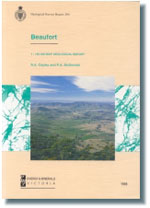GSV Report 104 - Beaufort 1:100 000 map area geological report
 |
| |||||||||||||||
Product description:Download The downloadable version of this report is supplied in PDF format and is a large file (32.5MB). Abstract This report describes the geology of the area covered by the Beaufort 1:100 000 mapsheet 7523. It gives a comprehensive account of the geological history and landscape evolution, Palaeozoic and Cainozoic rock units, and the metamorphic, structural and economic geology. It also presents a brief history of European settlement and gold mining, a description and interpretation of the geophysical properties of the rocks, and a comprehensive list of references. Special emphasis is placed on the Palaeozoic succession which includes a Cambro-Ordovician marine sedimentary rock sequence known as the Saint Arnaud Group, which is subdivided into three formations. The Warrak Formation consists of interbedded turbiditic sandstone and slate, with abundant thick silt-dominated packages and some black shale, and is faulted against other formations of the Saint Arnaud Group. The Beaufort Formation consists of turbiditic sandstone and abundant dark pyritic slate and underlies the Pyrenees Formation, which consists of monotonous thick bedded turbiditic sandstone and minor slate. Numerous I-type plutons intrude the Saint Arnaud Group, many of which have been differentiated and accurately mapped for the first time. Detailed descriptions (including petrographic descriptions) are given for all. The mineral assemblages developed in Saint Arnaud Group rocks during metamorphic events that accompanied deformation and granite intrusion are described in detail. Relationships between metamorphism, deformation, and granite intrusion have been used to establish their relative timing which also constrains the age of some gold mineralisation. The Palaeozoic rocks were affected by two major deformations: the pre-Lower Devonian, Benambran Deformation, and the Middle Devonian Tabberabberan Deformation. Particular emphasis is placed on describing and interpreting the different structural styles associated with these events. The ?Benambran Deformation (D1-2) is characterised by ductile folding, and intense cleavage development adjacent to large scale thrust faults. The Tabberabberan Deformation (D3-4) is characterised by brittle faulting and crenulation cleavage formation, particularly in the vicinity of earlier large-scale thrust faults which have been reactivated. Quartz and precious metal mineralisation may have occurred during both episodes of deformation. The post-Palaeozoic history is one of prolonged erosion, which intensified after the Cretaceous uplift. The landscape and its evolution, and Cainozoic sedimentation and volcanism, are described in the context of this uplift. Descriptions are supplied for all metallic and non-metallic mineral deposits and occurrences, and mine production data, and excursion localities are appended. Numerous photographs and line drawings complement the text. Bibliographic reference Cayley, R.A., and McDonald, P.A. Beaufort 1:100 000 map geological report. Geological Survey of Victoria Report 104. Related products:
| ||||||||||||||||


